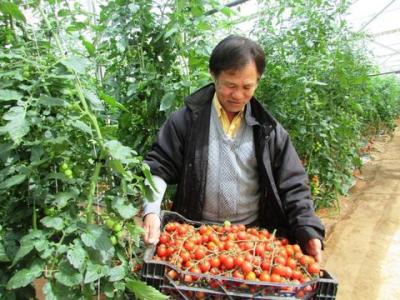Japan helps Lam Dong become an hi-tech agriculture hub

A farmer harvests tomatoes in Lam Dong Province. The province is poised to become a hi-tech agricultural hub with Japanese assistance and investment. — Photo bp.blogspot.com
A comprehensive agriculture development project with multiple approaches including agri-tourism has delivered promising results in Lam Dong Province, officials and businesses say.
The project, part of a Viet Nam-Japan development co-operation programme is primarily supported by the Japan International Co-operation Agency (JICA).
The overall aim of the project is to turn the province and the Central Highlands region into a high-value agriculture hub in Southeast Asia.
Lam Dong authorities have worked together with Japanese professionals from JICA as well as investors and entrepreneurs from Japan to carry out research, surveys and hold conferences to reach consensus on developing the agriculture sector under the public-private partnership (PPP) model since the second quarter of 2015.
All stakeholders have agreed on a development model with varied approaches that will improve agricultural investment environment in the region. Even in its early stages, the project is expected to open new opportunities for socioeconomic progress.
JICA has sent experts to counsel and help Lam Dong access production and post harvest technologies, as well as achieve vertical and horizontal integration for production, consumption and export.
The objective is to take Da Lat- Lam Dong to new heights as Viet Nam’s top agriculture brand, one of Southeast Asia’s top agritourism attractions and a high-quality human resources training centre for the agricultural sector.
Nguyen Van Son, Director of Lam Dong’s Department of Agriculture and Rural Development, said that in addition to the nascent growth of agritourism, agricultural product quality has improved significantly under the project.
The project has promoted agritourism as a potential profit maker, attracted the attention of and investment from more than 30 local businesses, he noted.
Nguyen Van Duong, head of the Da Lat-based Vietnam Hydroponic Produce Import Export Company Limited, said that his company had opened its farm to visitors so that they could see first-hand the high-tech agriculture production models being implemented, with the highlight being the company’s hydroponic plant crops.
In opening up to the public, the company seeks to broaden its market influence, develop its brand name and contribute to the region’s high tech agricultural development, he said.
Son said that Lam Dong has performed well in its endeavour to develop a high quality agricultural industry with increasing value and productivity. JICA’s support has helped address several problems that still remain in production, organisation and brand building, particularly for key products like Da Lat’s flowers and vegetables. They have built integration chains between farmers and farmers, and farmers and businesses to generate a large value of products of uniform export quality.
With strengthening co-operation between JICA and Lam Dong, more Japanese businesses have visited the province, seeking investment opportunities. So far, Japanese firms have invested in 11 projects with a total registered capital of more than US$32 million.
Lam Dong authorities have said that they aim to complete soon the construction of an agricultural industrial complex of more than 300ha to meet demand for land, improve production of high-end agricultural goods, and attract more investment from Japan.
Of a total of 142 countries and territories, Japan is the second leading investor in Viet Nam after South Korea, with projects worth about $42 billion.
Có thể bạn quan tâm
 5 traits global consumers want to know about food
5 traits global consumers want to know about food Trends that originated in Europe and the US are going global, and food producers should take notice or risk being left behind.
 World feed volume exceeds 1 billion metric tons
World feed volume exceeds 1 billion metric tons Global animal feed volume exceeded 1 billion metric tons of production in 2016, according to Alltech’s 2017 Global Feed Survey. Most notably, this milestone was
 Viet Nam rice exports set to face another tough year
Viet Nam rice exports set to face another tough year Despite facing difficulties, Viet Nam will strive to achieve rice exports of more than 5 million tonnes this year, the Viet Nam Food Association has said.